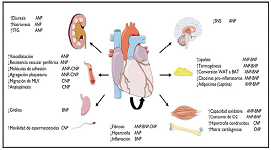
Asia Pacific Academy of Science Pte. Ltd. (APACSCI) specializes in international journal publishing. APACSCI adopts the open access publishing model and provides an important communication bridge for academic groups whose interest fields include engineering, technology, medicine, computer, mathematics, agriculture and forestry, and environment.

Follow up observation of permanent epicardial pacing
Vol 3, Issue 2, 2022
Download PDF
Abstract
Objective: To summarize the safety and long-term efficacy of epicardial permanent pacemaker implantation. Methods: 69 patients who underwent epicardial permanent pacemaker implantation in Wuhan Asian heart hospital from December 2009 to November 2019 and were followed up at least once after discharge were selected. In 23 children, single chamber pacemakers were implanted through right ventricular epicardium; Among 46 adults, 19 were implanted with pacing electrodes through left ventricular epicardium and 27 through right ventricular epicardium. Follow up the changes of electrode parameters and adverse events within 1 week, 1~3 months, 1~3 years and more than 5 years after operation. Results: Right ventricular electrodes were fixed in 50 cases, of which 37 cases were fixed on the right ventricular diaphragmatic surface and 13 cases were fixed on the right ventricular outflow tract; the left ventricular electrodes were fixed in 19 cases, of which 15 were fixed in the lateral wall of the left ventricle, 2 in the posterior wall of the left ventricle, and 2 in the diaphragmatic surface of the left ventricle. The median follow-up was 48.6 months. All 69 patients were discharged smoothly without operation related complications. Two patients with giant left ventricular cardiomyo pathy died of heart failure after cardiac resynchronization therapy (CRT), and one patient with CRT implantation underwent heart transplantation 12 months after operation because of poor efficacy. The pulse generator was replaced in 12 cases because the pa cemaker battery was exhausted. Electrode breakage occurred in 4 cases, and bag infection occurred in 1 case. The ventricular thresholds (median) within 1 week, 1~3 months, 1~3 years and more than 5 years after epicardial electrode implantation were 1.0 v/0.4 ms, 0.75 v/0.4 ms, 0.8 v/0.4 ms and 1.0 v/0.4 ms respectively. The left ventricular epicardial electrode threshold was the same as that of the right ventricle, and that of children and adults. Conclusion the parameters of epicardial electrode are stable for a long time, but the safety is not good
Keywords
References
- Renchonglei Must epicardial pacing electrode be a substitute? Chinese Journal of medicine. 2017; 97(16): 1204-1216.
- Kwak JG, Kim SJ, Song JY, et al. Permanent Epicardial Pacing in Pediatric Patients: 12-Year Experience at a Single Center. The Annals of Thoracic Surgery. 2012; 93(2): 634-639. doi: 10.1016/j.athoracsur.2011.09.072
- Silvetti MS, Drago F, Grutter G, et al. Twenty years of paediatric cardiac pacing: 515 pacemakers and 480 leads implanted in 292 patients. EP Europace. 2006; 8(7): 530-536. doi: 10.1093/europace/eul062
- Paech C, Kostelka M, Dähnert I, et al. Performance of steroid eluting bipolar epicardial leads in pediatric and congenital heart disease patients: 15 years of single center experience. Journal of Cardiothoracic Surgery. 2014; 9(1). doi: 10.1186/1749-8090-9-84
- Tomaske M, Gerritse B, Kretzers L, et al. A 12-Year Experience of Bipolar Steroid-Eluting Epicardial Pacing Leads in Children. The Annals of Thoracic Surgery. 2008; 85(5): 1704-1711. doi: 10.1016/j.athoracsur.2008.02.016
- Ren C, Jiang S, Xiao C, et al Clinical application of epicardial permanent pacemaker implantation during cardiac surgery. Chinese Journal of medicine. 2017; 97(16): 1227-1234.
- Song MK, Kim NY, Bae EJ, et al. Long-term Follow-up of Epicardial Pacing and Left Ventricular Dysfunction in Children with Congenital Heart Block. The Annals of Thoracic Surgery. 2020; 109(6): 1913-1920. doi: 10.1016/j.athoracsur.2019.09.06
- Garikipati NV, Mittal S, Chaudhry F, et al. Comparison of Endovascular Versus Epicardial Lead Placement for Resynchronization Therapy. The American Journal of Cardiology. 2014; 113(5): 840-844. doi: 10.1016/j.amjcard.2013.11.040
- Rickard J, Johnston DR, Price J, et al. Reverse ventricular remodeling and long-term survival in patients undergoing cardiac resynchronization with surgically versus percutaneously placed left ventricular pacing leads. Heart Rhythm. 2015; 12(3): 517-523. doi: 10.1016/j.hrthm.2014.11.013
- Marini M, Branzoli S, Moggio P, et al. Epicardial left ventricular lead implantation in cardiac resynchronization therapy patients via a video‐assisted thoracoscopic technique: Long‐term outcome. Clinical Cardiology. 2019; 43(3): 284-290. doi: 10.1002/clc.23300
- Cho S, Kim WH, Hyun K, et al. Long term results of permanent epicardial pacing in neonates and infants. Journal of Cardiothoracic Surgery. 2015; 10(S1). doi: 10.1186/1749-8090-10-s1-a207
- Chen J. Comparative study on different implantation sites of permanent pacemaker electrodes in children [Master’s thesis]. Southern Medical University; 2014.
- Qi S, Wang D, Li J, et al. Follow up of four cases of epicardial electrode lead placement through thoracotomy. Chinese Journal of cardiac pacing and electrophysiology. 2014; 28(02): 175-184.
- Li L, Qiao F, Zhou G. Application of epicardial pacing lead in cardiac resynchronization therapy. Chinese Journal of circulation. 2017; 32(z1): 711-719.
- Kamath GS, Balaram S, Choi A, et al. Long-term outcome of leads and patients following robotic epicardial left ventricular lead placement for cardiac resynchronization therapy. Pacing and Clinical Electrophysiology. 2010; 34(2): 235-240. doi: 10.1111/j.1540-8159.2010.02943.x
Supporting Agencies
Copyright (c) 2022 Jia Li, Hongwei Han, Zhen Li, Hua Yan, Ping Jiang, Hongwei Yi, Wenlong Kai, Xi Su, Liang Tao

This work is licensed under a Creative Commons Attribution 4.0 International License.

This site is licensed under a Creative Commons Attribution 4.0 International License (CC BY 4.0).

Prof. Prakash Deedwania
University of California,
San Francisco, United States




